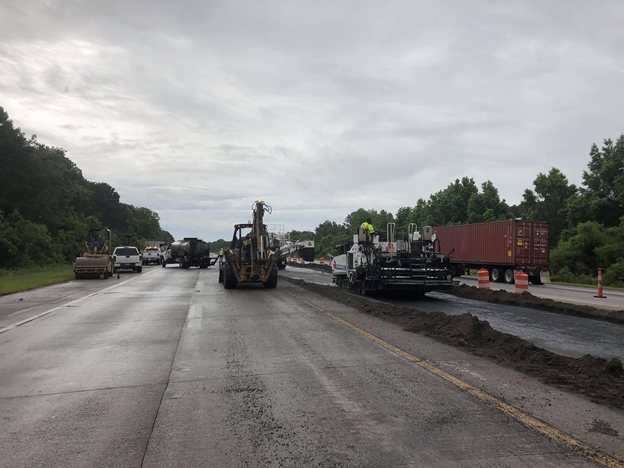Transportation infrastructure will be redefined in this century. Not just the modes that move goods and people, but how those systems are built and interact with the communities that they connect.
While robotics in manufacturing become more commonplace, the availability of this tech is left lacking for construction contractors. One sector decidedly, transportation construction, will benefit the public with the introduction of emerging technologies. This area presents unique building challenges and has its own rules to live by. The motoring public and heavy equipment are constantly moving within a confined, linear space. Workers, commuters, and commerce must learn to coincide here.
Innovations in roadway construction will mirror manufacturing. Building and maintaining a road is much like an assembly line. Any feature within the workzone can be referenced in three ways; station (distance from the project starting point), offset (lateral distance from the centerline of the roadway), and elevation (its height relative to mean sea level).
This axial geospatial control is incredibly well-suited to transportation projects, given their sheer length. Critical path activities often overlap in their physical area, such as prepping an old road surface before paving on top of it with new asphalt. A series of machines thus follow each other, performing sequential operations. Equipment manufacturers such as Caterpillar refer to this as the “paving train.” With the ability to reference xyz for any given site, and the assembly-line style approach, prime engineering opportunities are presented with heavy equipment.

Coming to a Highway Near You
Safety comes before productivity and the benefits of a cohesive network of transportation modes. Foremost, innovations must take on tasks that pose a quantitatively high risk of incident or injury, or directly engage in life-saving functions. Each year, backing accidents cause jobsite injuries, death, and lost time. Being struck by vehicles, heavy equipment, and other objects is the top cause of injuries and the second cause of death for construction workers, killing more than 150 workers in one year alone. Controlling traffic in and around job sites and work zones is crucial with ever-increasing mechanization.
Specific to roadway construction is the venerable crash attenuator. This physical barrier, mounted behind a modified truck, protects life and equipment. The device acts as a warning to trailing motorists—the trucks are supplemented with illuminated arrow and message boards. Pertinent to mobile operations, such as epoxy paint and thermoplastic “striping,” they are intended to move along lanes that are continuously open to traffic.
An example of automation in the transportation construction sector, with its roots in military vehicle convoys, is a joint effort between Kratos Defense & Security Solutions and Royal Truck & Equipment. Their system consists of a truck mounted crash attenuator (TMA) and a self-driving leader/follower program. Omitting a human truck driver from a potential high-speed crash could save lives, while still providing critical protection within the mobile operation. This technology is illustrative of how automation removes humans from the line of fire.
Inspired to Act and Create
Emerging modes of transportation and changing landscapes must be accounted for by planners, design engineers, and builders. It is also these professionals that proponents of automation must demonstrate their strengths to. Are there environmental factors that make an unmanned approach an attractive option?
For example, a solution for coastal urban flooding can be combined with a hub for electric vertical takeoff and landing (eVTOL) vehicles. A multi-faceted, private-and-public approach will take some pressure off roads and drainage needing constant troubleshooting. Saving money in the responsible agency’s maintenance budget will thus allow for more comprehensive improvements. The same logic applies to contractors that are interested in automated equipment—they will want the most cost-effective means to implement and maintain it in a way that still meets government specs. Engineering modular systems to retrofit existing pieces of construction equipment is one such approach. One embodiment might perform tasks in conjunction with human operators and laborers (and certainly if a contract has an automation-to-human labor ratio stated).
An Evolving Workforce
Ultimately, people will remain a critical component of daily activities on job sites. Construction across all sectors is litigious. Accountability is required at every level of the job and is expected with public funds. As for careers within the industry itself—with an influx of technology, the personnel seen on the jobsite will be a mix of two worlds. Traditional construction management and supervision, with skilled trades knowledge, will interface with automated equipment technicians versed in the tasks that their machines must perform. They will work together towards a goal, by virtue of completing activities on-time and at the level of quality needed.
Sampling and testing personnel may also discover a computerized proxy. Traditional testing and sampling procedures are prone to inconsistencies which can lead to contention and cost. Aids such as GPS monitoring equipment are already being utilized for gathering quality control metrics. A new frontier for engineers is beckoning with smart equipment that can test material for compliance, in addition to performing critical path activities. Standards set by public agencies and technical institutes are constantly being reevaluated as new products and methods arise. The future of sampling and testing, a necessity for any project, should be streamlined for instantaneous reporting with agency-certified, dependable machine logic.
Computerized, real-time earned value management can also simplify the project when it comes to completion reporting and payment. Playing into these aspects also is environmental monitoring and best management practices. A critical component of all earth-fast projects, monitoring of contaminants, sediments, and stormwater, could also protect the public well-being if incorporated into emerging technologies. Automating construction tasks thus represents the culmination of different disciplines, including environmental engineering, geospatial surveying, heavy equipment operation, project management, and software development.




